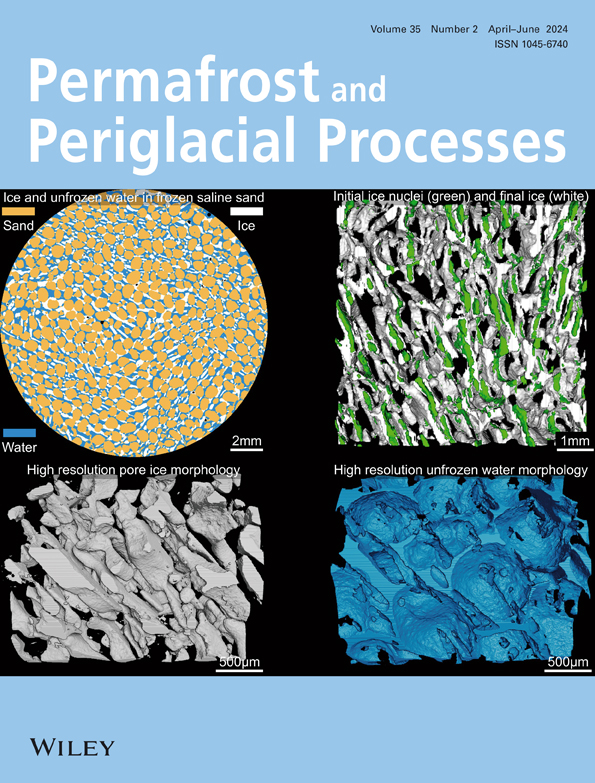电阻率层析成像用于永冻土界面探测的正演模型系统评价
IF 3.3
3区 地球科学
Q2 GEOGRAPHY, PHYSICAL
引用次数: 9
摘要
使用正演建模,系统地研究了电阻率层析成像(ERT)作为一种定位永久冻土环境中冻结到未冻结界面的方法的准确性。评估了冻结区域电阻率、厚度和横向连续性的变化、表面解冻层厚度的变化以及不同阵列类型对冻结-未冻结界面检测和定位的影响。这些简单场景的结果表明,冻结和未冻结地面之间的边界由最大梯度更准确地指示,而不是基于表面解冻层底部电阻率的固定阈值。冻结区的电阻率在解释的边界位置中起着重要作用,高电阻率值导致深度处模型灵敏度降低,冻结区解释基底的不确定性增加,特别是在横向连续的永久冻土中。冻土层厚度越厚,冻土带基底的解释误差也越大,而融化层厚度的作用越小。在横向不连续的永久冻土中,更宽的冻结体导致冻结区域底部的边界变得不那么明显。阵列类型影响反演电阻率模型的外观和使用阈值方法定位的冻结-未冻结边界,但当使用最大梯度方法时,阵列类型之间的边界位置是可比较的。该合成模型表明,应谨慎解释ERT图像中未冻结和冻结区域之间的边界,特别是在深度敏感性较低的富冰、横向连续的永久冻土中。我们得出的结论是,正向建模是永久冻土调查的有用工具,既可以在实地调查前评估实现ERT调查目标的可能性,也可以在获得实地数据后作为解释性辅助。本文章由计算机程序翻译,如有差异,请以英文原文为准。
A systematic evaluation of electrical resistivity tomography for permafrost interface detection using forward modeling
The accuracy of electrical resistivity tomography (ERT) as a method for locating frozen‐to‐unfrozen interfaces in permafrost environments was investigated systematically for simplified scenarios using forward modeling. The impacts of varying the resistivity, thickness, and lateral continuity of the frozen region, altering the thickness of the surface thaw layer, and of differing array types were evaluated in relation to the detection and positioning of frozen–unfrozen interfaces. The results from these simple scenarios show that boundaries between frozen and unfrozen ground are more accurately indicated by maximum gradients rather than a fixed threshold value based on the resistivity at the base of the surface thawed layer. The resistivity of the frozen region plays a significant role in interpreted boundary locations, with high resistivity values causing a decrease in model sensitivity at depth and increased uncertainty in the interpreted base of the frozen zone, particularly in laterally continuous permafrost. Error in the interpreted base of the frozen zone also increases for thicker permafrost bodies, while thaw layer thickness plays a less significant role. In laterally discontinuous permafrost, wider frozen bodies cause the boundary at the base of the frozen region to become less distinct. Array type affected the appearance of the inverted resistivity models and the frozen–unfrozen boundaries located using the threshold method, but boundary locations were comparable among array types when the maximum gradient method was used. This synthetic modeling showed that the boundaries between unfrozen and frozen regions in ERT images should be interpreted with caution, particularly in ice‐rich, laterally continuous permafrost where sensitivity at depth is low. We conclude that forward modeling is a useful tool for permafrost investigations, both for assessing the likelihood of achieving ERT survey goals prior to fieldwork, and as an interpretive aid after field data have been acquired.
求助全文
通过发布文献求助,成功后即可免费获取论文全文。
去求助
来源期刊
CiteScore
9.70
自引率
8.00%
发文量
43
审稿时长
>12 weeks
期刊介绍:
Permafrost and Periglacial Processes is an international journal dedicated to the rapid publication of scientific and technical papers concerned with earth surface cryogenic processes, landforms and sediments present in a variety of (Sub) Arctic, Antarctic and High Mountain environments. It provides an efficient vehicle of communication amongst those with an interest in the cold, non-glacial geosciences. The focus is on (1) original research based on geomorphological, hydrological, sedimentological, geotechnical and engineering aspects of these areas and (2) original research carried out upon relict features where the objective has been to reconstruct the nature of the processes and/or palaeoenvironments which gave rise to these features, as opposed to purely stratigraphical considerations. The journal also publishes short communications, reviews, discussions and book reviews. The high scientific standard, interdisciplinary character and worldwide representation of PPP are maintained by regional editorial support and a rigorous refereeing system.

 求助内容:
求助内容: 应助结果提醒方式:
应助结果提醒方式:


